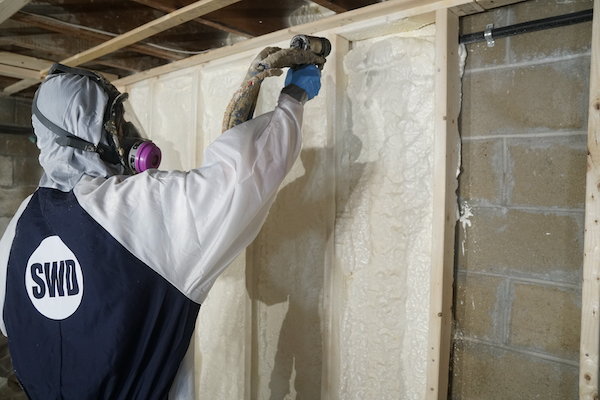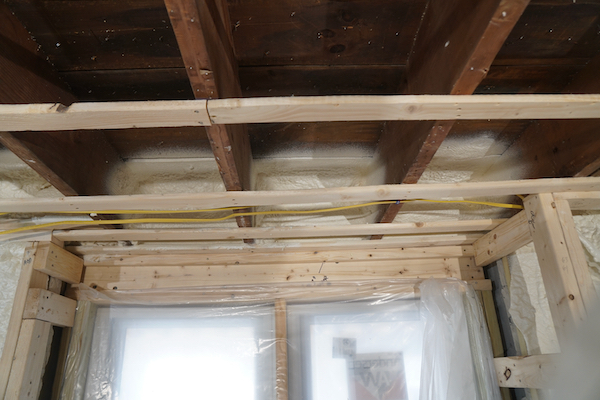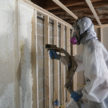Basement Wall Insulation – Closed Cell Spray Foam
Using Closed Cell Spray Foam to Insulate a Basement Wall
Here at Concord Carpenter we strongly recommend using Closed Cell spray foam to insulate a below-grade basement wall. Conditioned basement space has a never-ending battle against moisture gain and heat loss. Closed Cell Spray Polyurethane Foam (CCSPF), when installed properly by a trained professional, can be the best defense against high moisture, mold growth, and heat loss. We work with a local contractor, InsulationDoneRight.com, that follows best practices.
Closed Cell vs Open Cell Spray Foam
Not all spray foams are created equal. Both open-cell and closed-cell spray foams results from a chemical process by mixing isocyanate and polyol at the site of application that rapidly expands between 30-100 times its size. Spray foam is applied by a high-pressure applicator gun directly to the area being insulated. The foam rapidly cures and adheres in place.
Open-cell spray foam has a higher expansion ratio of 100:1 than closed-cell and is a great thermal and sound insulator. Open-cell foam has an R-value of roughly 3.9 per inch. The cell structure of the foam isn’t completely closed and as a result, the foam is a bit softer and more flexible. With adequate depth, open-cell can act as a good air barrier but it cannot act as a vapor barrier.
Closed-cell spray foam [CCSPF] has a lower expansion ratio of about 30:1 and results in a foam that is denser and more rigid than open cell. The closed-cell foam has a cell structure that is completely closed. This closed-cell nature allows CCSPF to act as a vapor barrier in addition to having a fantastic R-value of 7 per inch.
Preparing for Closed Cell Spray Foam
As discussed above CCSPF can serve as a vapor barrier. In a finished basement with conditioned spaces, a vapor barrier is absolutely necessary to prevent moisture buildup and mold growth. In order to achieve a complete envelope for vapor and thermal protection, it is recommended to install all exterior wall studs at least 1″ away from the wall. This will allow the CCSPF to achieve a complete vapor barrier between the porous concrete wall and your interior building material. Additionally this will serve as a thermal break and prevent conductive heat loss through what is called thermal bridging through the studs.
Closed-cell spray foam requires all areas to be insulated to be open to the installer. Framing will have to be complete but it is highly recommended to have all electrical and other utility runs completed and inspected as well before installation. Closed-cell foam cures extremely hard and will bury most electrical lines and conduit attached to the exterior wall.
Dealing with Utilities
Our spray foam contractor, InsulationDoneRight.com, recommends keeping utility equipment separate from spray foam in remodels where panels and equipment are already mounted to the wall. To do this it is recommended that you frame a room around your utility equipment, and insulate those walls around the room. This effectively creates a cold, or non-conditioned room for the utility equipment. In a new construction build it is recommended you hang a wall of the concrete 3-4 inches to allow for foam board to be slid beyond the wall or frame a small 8-12′ section of wall and have that insulated prior to the installation of the mechanicals.
Creating this utility room allows you to keep the spray foam material away from utility runs that are going to be frequented or upgraded in the future. It is best to stop the spray foam short of these areas and to treat the utility space as cold storage. This will allow future work to be accomplished in these areas without the need to remove the foam insulation. Don’t forget to insulate these interior walls and ceiling space to prevent heat loss into this cold storage area.
Cover Everything from Overspray
Spray foam install can be messy. A good installer will not waste too much material with excess splatter but some spray will make its way to other surfaces. If there are any items in the area that need to be protected, drape sheets of plastic or tape to cover.
What to Expect During Install
Spray foam is composed of two-part, commonly referred to as an A-side and a B side. A trained spray foam installation crew will have a large truck with all the equipment and chemicals on board. They will measure and monitor the conditions of the space of the installation like temperatures, humidity, and atmospheric pressure. This is to ensure a proper chemical reaction and application. Back in the truck, equipment may take some time to warm up and operating pressures and chemical temperatures will be adjusted as needed.
Spray foam installation can be messy and hazardous to your health. A trained installer will be outfitted in a full Tyvek suit with a full-face respirator with organic vapor filters. Once the spray foam installation has begun, unless you have the appropriate personal protective equipment and a reason to be there, it is best to vacate the premise. If this job is on a remodel and the above floor is inhabited, the inhabitants will have to leave the premise for the installation and a period of 24 hours after the installation is complete. As the foam cures, the product will go through a phase called off-gassing. The rule of thumb for most products is to allow 24 hours for this process to complete and the air quality levels in the home to return to acceptable levels.

Closed Cell Spray Foam Limitations
CCSPF is a great air and vapor barrier but it is not effective at sealing liquid water leaks. If the basement in question has a problem with external liquid water migration, this issue can not be solved with spray foam. The sources and causes of the water need to be corrected before the spray foam is installed.
Ceiling Rim Joist Areas – An Area Often Overlooked
One of the best uses for closed-cell spray foam is to seal and insulate the exposed rim joist areas. The irregular shape of a rim joist and foundation can be a difficult area to insulate with other methods. However, great care needs to be taken in identifying areas where closed-cell spray foam might not be the best or safest option. CCSPF produces a very exothermic reaction. In other words, the chemical reaction that takes place once it is applied can create a great deal of heat. If the foam is sprayed in sufficient quantities in an enclosed space, an uncontrolled exothermic reaction can take place. This can melt hidden wires and even start fires. Additionally, the expanding foam can create enough pressure to blow out and damage the structure.
Open-cell spray foam is the better option in some of these areas. Along with more traditional methods like fiberglass or mineral wool batts.
Be sure to discuss these concerns and options with your professional insulation installer. For more information regarding insulating the ceiling rim joists check out our in-depth article “Sealing and Insulating Rim Joists“. And for an in-depth look a the problems and challenges facing a basement remodel and the best practices to avoid mold check out our article and video “Basement Insulation – Best Practices to Avoid Mold“.













